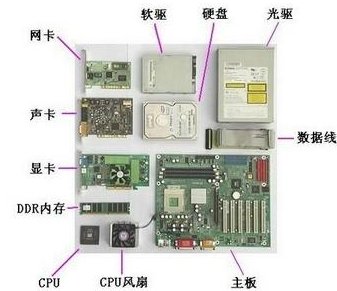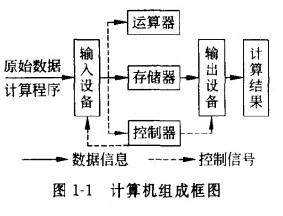计算机硬件由CPU(Central Processing Unit)、存储器、输入设备、输出设备组成。
CPU通常由控制单元(控制器)和算数逻辑单元(运算器)组成。


运算器:负责进行算数运算和逻辑运算。组成运算器的部件有寄存器、控制电和执行部件等。
控制器:负责从内存中取回命令、分析指令并控制其他部件共同完成指令的执行。
存储器:存储程序(程序由若干指令组成)和数据。
分类:
内存:有一个个基本电路组成,每一个基本电路都可以存储一位二进制数
一个基本电路成为一个位(Bit)
8个位合并组成一组,每一组成为一个字节(byte),也成为一个存储单元。
内存中的每一个字节都有一个唯一的编号,该编号称为内存地址。
内存特点:
(1)一个内存单元永远不能为空,总是有内容(总是代表8个二进制数),但其内容不一定有意义。
(2)内存的存取速度比外存快得多。
(3)内存中存储的信息靠电维持,一旦掉电则信息丢失(电容自动放电)。内存需要额外的电路每隔一段时间间隔进行一次刷新操作。所谓刷新,就是对电量超过1⁄2容量的电容进行充电,
对少于1/2容量的电容进行放电。
(4)内存可以直接和CPU进行信息交换,即CPU可以直接读写内存。
外存:外存包括硬盘、U盘、光盘和软盘。
外存特点:
(1)外存靠机械部件驱动,故存取速度慢。
(2)外存上的信息不容易丢失,不需要一直通电维持。
(3)外存上的信息不能直接被CPU处理,必须先装入内存,才能被CPU读取,反之,CPU若要向外存写数据,也必须经过内存。
存储器的特性:
1.存储器中存的信息,不管读多少次,该信息不会丢失,可反复读取。
2.如果存储单元已经存了一个数据,又向其中存了一个新数据,则新数据把旧数据覆盖。
输入设备:用来输入程序或输入数据的设备。
如:键盘、鼠标、扫描仪、照相机和摄像头。
输出设备:输出程序的运行结果。
如:显示器、打印机、绘图仪和照相机。
The computer hardware is composed of a CPU (Central Processing Unit), a memory, an input device, and an output device.
The CPU usually consists of a control unit (controller) and an arithmetic logic unit (operator).
Operator: responsible for arithmetic and logic operations. The components that make up the operator are registers, control power, and execution components.
Controller: Responsible for retrieving commands from memory, analyzing instructions, and controlling other components to complete the execution of instructions.
Memory: Stores programs (programs consist of several instructions) and data.
classification:
Memory: There are one basic circuit components, each basic circuit can store one binary number
A basic circuit becomes a bit (Bit)
The eight bits are combined into one group, each of which is one byte (byte) and also becomes a storage unit.
Each byte in memory has a unique number, which is called a memory address.
Memory features:
(1) A memory unit can never be empty, always has content (always representing 8 binary numbers), but its content does not necessarily make sense.
(2) Memory access speed is much faster than external storage.
(3) The information stored in the memory is maintained by electricity. Once the power is lost, the information is lost (the capacitor is automatically discharged).
The memory requires additional circuitry to perform a refresh operation at intervals. The so-called refresh is to charge the capacitor with more than 1⁄2 capacity.
Discharge capacitors with less than 1/2 capacity.
(4) The memory can directly exchange information with the CPU, that is, the CPU can directly read and write the memory.
External storage: External storage includes hard disks, USB flash drives, optical disks and floppy disks.
External storage features:
(1) The external memory is driven by mechanical components, so the access speed is slow.
(2) The information on the external storage is not easy to lose, and it does not need to be powered on all the time.
(3) The information on the external memory cannot be directly processed by the CPU. It must be loaded into the memory before it can be read by the CPU. Conversely, if the CPU wants to write data out, it must pass through the memory.
Memory characteristics:
1. The information stored in the memory, no matter how many times it is read, the information will not be lost and can be read repeatedly.
2. If the storage unit already has a data and a new data is stored in it, the new data overwrites the old data.
Input device: A device used to enter a program or enter data.
Such as: keyboard, mouse, scanner, camera and camera.
Output device: The result of the output program.
Such as: monitors, printers, plotters and cameras.